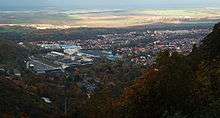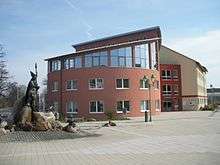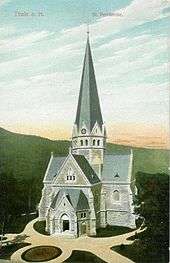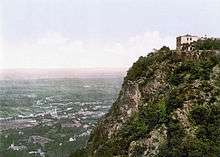Thale
| Thale | ||
|---|---|---|
 | ||
| ||
 Thale | ||
Location of Thale within Harz district  | ||
| Coordinates: 51°45′N 11°3′E / 51.750°N 11.050°ECoordinates: 51°45′N 11°3′E / 51.750°N 11.050°E | ||
| Country | Germany | |
| State | Saxony-Anhalt | |
| District | Harz | |
| Government | ||
| • Mayor | Thomas Balcerowski (CDU) | |
| Area | ||
| • Total | 137.62 km2 (53.14 sq mi) | |
| Population (2015-12-31)[1] | ||
| • Total | 17,639 | |
| • Density | 130/km2 (330/sq mi) | |
| Time zone | CET/CEST (UTC+1/+2) | |
| Postal codes | 06502 | |
| Dialling codes | 03947, 03946, 039456 | |
| Vehicle registration | HZ | |
| Website | www.thale.de | |
Thale (pronounced [ˈtaːlə]) is a town in the Harz district in Saxony-Anhalt in central Germany.
Geography
It is situated on the river Bode, approximately 8 km west of Quedlinburg. Thale Central Station is the terminus of the Magdeburg–Thale railway.
History
The settlement of Thale probably emerged at the beginning of the 10th century. It was first mentioned in 936 in connexion with the neighbouring Wendhusen Abbey, which had been founded before 840 as a chapter of canonesses (Kanonissenstift) and was one of the first abbeys on Saxon soil. In the period that followed the abbey came under the guardianship of the chapter in Quedlinburg. The village was described in 1231 as Dat Dorp to dem Dale (from 1288 it was given the description de valle, and from 1303 as von Thale). The abbey was destroyed in 1525 during the Peasants' War.
From 1445 the records show that there had been an ironworks in Thale. It was rebuilt in 1648 after the devastation of the Thirty Years' War as the Berghaus zum Wilden Mann, but was fully destroyed in 1670. In 1686 a small hammer mill was established out of which a new ironworks later developed that benefited especially from its proximity to the ore deposits and the availability of wood. It lasted until 1714. In 1740 a business was opened again. For a short time this ironworks was owned by Frederick the Great. In 1831 the first wrought-iron wagon axle to be made in Germany was manufactured here. In 1835 the oldest sheet steel enamel works in Europe was founded in Thale. Following the town's connexion to the railway network in 1862 with a line to Berlin the place flourished as did the number of workers. Whilst the iron industry had only 350 workers in 1872, by 1905 there were as many as 4,400. In particular, the production of enamel contributed to Thale's international renown; in its heyday Thale produced no less than 10% of the world's production. In 1910 Karl Liebknecht, Rosa Luxemburg and Clara Zetkin spoke to Thale's workers. From 1916 steel helmets were produced in Thale. In the Second World War Thale had the monopoly on this product (from 1934).
Tourism blossomed from the 19th century onwards in connexion with the radon rich water of the Hubertus Spring, which had been opened up in 1836. As a result, various literary figures visited the place, including Heinrich Heine (Die Harzreise) and Theodor Fontane and especially the Bode Gorge. In addition tourists from Berlin enjoyed the summer resort of Thale. This encouraged the connexion of Thale in 1862 to the railway line from Wegeleben. In 1909 a branch line from Blankenburg (Harz) followed. In 1922 the resort was given town rights. From 12 to 14 June 2009 Thale was the venue for the Saxony-Anhalt Day held under the motto Thale sagenhaft ("Legendary Thale"), and attracted around 200,000 visitors.
Incorporation of other parishes
Warnstedt was incorporated in 2003.[2][3] In 2009 a total of seven municipalities were incorporated on four separate dates.[4] Westerhausen was added in 2010.[5] Allrode became a part of the borough of Thale in 2011.[6]
The changes in area are shown in a special table.
| Former parish | Date |
|---|---|
| Allrode | 1 January 2011 |
| Altenbrak | 1 July 2009 |
| Friedrichsbrunn | 23 November 2009 |
| Neinstedt | 1 January 2009 |
| Stecklenberg | 23 November 2009 |
| Treseburg | 1 July 2009 |
| Warnstedt | 21 December 2003 |
| Weddersleben | 1 January 2009 |
| Westerhausen | 1 September 2010 |
- Area of the borough of Thale
| Date | Area |
|---|---|
| 21 December 2003 | 38.13 km2 |
| 1 January 2009 | 50.13 km2 |
| 1 July 2009 | 78.47 km2 |
| 23 November 2009 | 102.79 km2 |
| 1 September 2010 | 120.21 km2 |
| 1 January 2011 | 137.62 km2 |
Population growth
The growth of population (from 1995 censuses were taken every 31 December):[7]
|
|
Politics
Town council

(according to the official result of the elections for the Thale town council on 7 June 2009; Voter participation: 42.88%, Changes from the previous election in brackets)
- CDU – 59.2%, 17 seats (unchanged)
- Die Linke – 13.3%, 4 seats (unchanged)
- FDP – 8.2%, 2 seats (+1)
- SPD – 7.4%, 2 seats (-1)
- GRÜNE Bürger Fraktion – 4.9%, 3 seats (+3)
- Wählergruppen – 4.1%, 1 seat (-1)
- Einzelbewerber – 2.9%, 0 seats (-1)
Coat of arms
The coat of arms was approved on 11 July 1996 by the Magdeburg Regional Council (Regierungspräsidium).
Partnerships
Since 1990 Thale has had a town partnership with Seesen (Lower Saxony) on the northwest edge of the Harz and, since 1998, with the French town of Juvisy-sur-Orge, 18 km from Paris, as well as Tillabéri in Niger, northwest of the River Niger.
Culture and places of interest




Museums
- Wendhusen Abbey which specialises in the theme of "canoness chapters" (Kanonissenstifte)
- Thale Smelting Museum
- Walpurgis Hall
Buildings
- The former Wendhusen Abbey, dating to the Carolingian period
- The Hotel Zehnpfund, built in 1863 and once the biggest summer hotel in Germany
- St. Peter's Church, completed in 1906
- The Roman Catholic Church of the Sacred Heart (Herz-Jesu-Kirche), completed in 1910 and 1911
- The prominent windmill in the village of Warnstedt
Other cultural sites
- Hexentanzplatz ("Witches' Dancefloor")
- Harz Mountain Theatre, Thale
- Wildlife park (Tierpark)
- Sommerrodelbahn
- Bau-Spiel-Haus
- Funpark
- Central Theater (cinema)
- Homburg Watchtower (Homburgswarte)
Natural monuments
- Bode Gorge - Thale is the gateway to the Bode Gorge which is overlooked by the Hexentanzplatz ("Witches' Dancefloor"), accessible on the Bode Gorge Gondola Lift, and the Roßtrappe, to which a chair lift runs. At the Hexentanzplatz is a large open-air theatre and a zoo.
- Teufelsmauer - near the villages of Weddersleben and Warnstedt lies the Teufelsmauer, one of the oldest nature reserves in Germany.
- Harz Witches' Path - The Harz Witches' Path (Harzer Hexenstieg), a long-distance footpath, runs from Thale for just under 100 km across the Harz to Osterode, passing various sights along the way including the Brocken, Torfhaus, Dammgraben and the Upper Harz Ponds.
Population history
|
|
Media
Thale is the setting of Theodor Fontane's novel Cécile. Fontane stayed in Thale a number of times between 1868 and 1884.
References
- ↑ "Bevölkerung der Gemeinden – Stand: 31.12.2015" (PDF). Statistisches Landesamt Sachsen-Anhalt (in German).
- ↑ Saxony-Anhalt State Office of Statistics on the 1994-2007 regional reforms
- ↑ StBA: Changes to the municipalities of Germany, see 2003
- ↑ StBA: Changes to the municipalities of Germany, see 2009, 1st and 2nd lists
- ↑ StBA: Changes to the municipalities of Germany, see 2010
- ↑ StBA: Changes to the municipalities of Germany, see 2011
- ↑ Contains data up to 1939
External links
| Wikisource has the text of the 1911 Encyclopædia Britannica article Thale. |
| Wikivoyage has a travel guide for Thale. |
- Official site for the City of Thale, with tourist info, etc.
